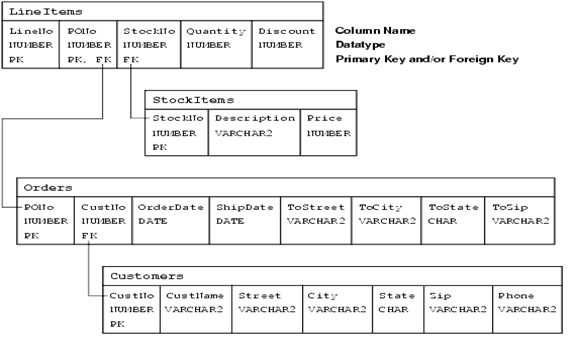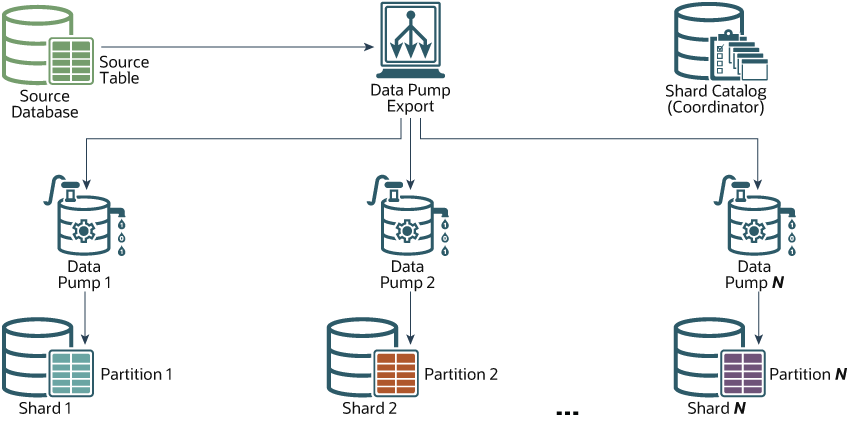6 Migrating to a Sharded Database
Migration from an existing non-sharded database to a sharded database consists of two phases: schema migration and data migration. Oracle Sharding provides guidelines for migrating your existing database schema and data to a sharded database.
The following approaches are recommended for database migration.
- Using Oracle Data Pump to Migrate to a Sharded Database
Using the examples and guidelines provided in the following topics, you can extract DDL definitions and data from the source database with the Oracle Data Pump export utility, and then use the Data Pump import utility against the database export files to populate the target sharded database. - Using External Tables to Load Data into a Sharded Database
Using the examples and guidelines in the following topics, you can load data into a sharded database by creating external tables and then loading the data from the external tables into sharded or duplicated tables.
Using Oracle Data Pump to Migrate to a Sharded Database
Using the examples and guidelines provided in the following topics, you can extract DDL definitions and data from the source database with the Oracle Data Pump export utility, and then use the Data Pump import utility against the database export files to populate the target sharded database.
If you already created the schema for your sharded database, you can go directly to the data migration topic.
- Migrating a Schema to a Sharded Database
Transition from a non-sharded database to a sharded database requires some schema changes. At a minimum, the keywordSHARDEDorDUPLICATEDshould be added toCREATE TABLEstatements. In some cases, the partitioning of tables should be changed as well, or a column with the shading key added. - Migrating the Sample Schema
As an example, to migrate the sample schema described above to a sharded database, do the following steps. - Migrating Data to a Sharded Database
Transitioning from a non-sharded database to a sharded database involves moving the data from non-sharded tables in the source database to sharded and duplicated tables in the target database. - Loading the Sample Schema Data
- Migrating Data Without a Sharding Key
As an example, the following steps illustrate how to migrate data to a sharded table from a source table that does not contain the sharding key.
Parent topic: Migrating to a Sharded Database
Migrating a Schema to a Sharded Database
Transition from a non-sharded database to a sharded database requires some
schema changes. At a minimum, the keyword SHARDED or
DUPLICATED should be added to CREATE TABLE statements.
In some cases, the partitioning of tables should be changed as well, or a column with the
shading key added.
To properly design the sharded database schema, you must analyze the schema and workload of the non-sharded database and make the following decisions.
- Which tables should be sharded and which should be duplicated
- What are the parent-child relationships between the sharded tables in the table family
- Which sharding method is used on the sharded tables
- What to use as the sharding key
If these decisions are not straightforward, you can use the Sharding Advisor to help you to make them. Sharding Advisor is a tool that you run against a non-sharded Oracle Database that you are considering to migrate to an Oracle Sharding environment.
To illustrate schema and data migration from a non-sharded to sharded database, we will use a sample data model shown in the following figure.
Figure 6-1 Schema Migration Example Data Model

Description of "Figure 6-1 Schema Migration Example Data Model"
The data model consists of four tables, Customers, Orders, StockItems, and LineItems, and the data model enforces the following primary key constraints.
-
Customer.(CustNo) -
Orders.(PONo) -
StockItems.(StockNo) -
LineItems.(LineNo, PONo)
The data model defines the following referential integrity constraints.
-
Customers.CustNo -> Orders.CustNo -
Orders.PONo -> LineItems.PONo -
StockItems.StockNo -> LineItems.StockNo
The following DDL statements create the example non-sharded schema definitions.
CREATE TABLE Customers (
CustNo NUMBER(3) NOT NULL,
CusName VARCHAR2(30) NOT NULL,
Street VARCHAR2(20) NOT NULL,
City VARCHAR2(20) NOT NULL,
State CHAR(2) NOT NULL,
Zip VARCHAR2(10) NOT NULL,
Phone VARCHAR2(12),
PRIMARY KEY (CustNo)
);
CREATE TABLE Orders (
PoNo NUMBER(5),
CustNo NUMBER(3) REFERENCES Customers,
OrderDate DATE,
ShipDate DATE,
ToStreet VARCHAR2(20),
ToCity VARCHAR2(20),
ToState CHAR(2),
ToZip VARCHAR2(10),
PRIMARY KEY (PoNo)
);
CREATE TABLE LineItems (
LineNo NUMBER(2),
PoNo NUMBER(5) REFERENCES Orders,
StockNo NUMBER(4) REFERENCES StockItems,
Quantity NUMBER(2),
Discount NUMBER(4,2),
PRIMARY KEY (LineNo, PoNo)
);
CREATE TABLE StockItems (
StockNo NUMBER(4) PRIMARY KEY,
Description VARCHAR2(20),
Price NUMBER(6,2)
);
Parent topic: Using Oracle Data Pump to Migrate to a Sharded Database
Migrating the Sample Schema
As an example, to migrate the sample schema described above to a sharded database, do the following steps.
Parent topic: Using Oracle Data Pump to Migrate to a Sharded Database
Migrating Data to a Sharded Database
Transitioning from a non-sharded database to a sharded database involves moving the data from non-sharded tables in the source database to sharded and duplicated tables in the target database.
Moving data from non-sharded tables to duplicated tables is straightforward, but moving data from non-sharded tables to sharded tables requires special attention.
Loading Data into Duplicated Tables
You can load data into a duplicated table using any existing database tools, such as Data Pump, SQL Loader, or plain SQL. The data must be loaded to the shard catalog database. Then it gets automatically replicated to all shards.
Because the contents of the duplicated table is fully replicated to the database shards using materialized views, loading a duplicated table may take longer than loading the same data into a regular table.
Loading Data into Sharded Tables
When loading a sharded table, each database shard accommodates a distinct subset of the data set, so the data in each table must be split (partitioned) across shards during the load.
You can use the Oracle Data Pump utility to load the data across database shards in subsets. Data from the source database can be exported into a Data Pump dump file. Then Data Pump import can be run on each shard concurrently by using the same dump file.
The dump file can be either placed on shared storage accessible to all shards, or copied to the local storage of each shard. When importing to individual shards, Data Pump import ignores the rows that do not belong to the current shard.
Figure 6-3 Loading Sharded Tables Directly to the Database Shards
Loading the data directly into the shards is much faster, because all shards are loaded in parallel. It also provides linear scalability; the more shards there are in the sharded database, the higher data ingestion rate is achieved.
Parent topic: Using Oracle Data Pump to Migrate to a Sharded Database
Loading the Sample Schema Data
As an example, the following steps illustrate how to move the sample schema data from a non-sharded to sharded database. The syntax examples are based on the sample Customers-Orders-LineItems-StockItems schema introduced in the previous topics.
Note:
You can make Data Pump run faster by using the PARALLEL
parameter in the expdp and impdp commands. For
export, this parameter should be used in conjunction with the %U wild card in
the DUMPFILE parameter to allow multiple dump files be created,
as shown in this example.
expdp uname/pwd@orignode SCHEMAS=uname directory=expdir dumpfile=samp_%U.dmp logfile=samp.log FLASHBACK_TIME=SYSTIMESTAMP PARALLEL=4 The above command uses four parallel workers and creates four dump files with suffixes _01, _02, _03, and _04. The same wild card can be used during the import to allow you to reference multiple input files.
Parent topic: Using Oracle Data Pump to Migrate to a Sharded Database
Migrating Data Without a Sharding Key
As an example, the following steps illustrate how to migrate data to a sharded table from a source table that does not contain the sharding key.
The examples of the Data Pump export and import commands in the previous topic do not include the LineItems table. The reason is that this table in the non-sharded database does not contain the sharding key column (CustNo). However, this column is required in the sharded version of the table.
Because of the schema mismatch between the non-sharded and sharded versions of the table, data migration for LineItems must be handled differently, as shown in the following steps.
Parent topic: Using Oracle Data Pump to Migrate to a Sharded Database
Using External Tables to Load Data into a Sharded Database
Using the examples and guidelines in the following topics, you can load data into a sharded database by creating external tables and then loading the data from the external tables into sharded or duplicated tables.
This data loading method is useful when the data to be loaded resides in external files, for example in CSV files.
External tables can be defined using the ORGANIZATION EXTERNAL keyword
in the CREATE TABLE statement. This table must be local to each shard
and not sharded or duplicated. Loading the data into the sharded or duplicated table
involves a simple INSERT … SELECT statement from an external table,
with a condition to filter only a subset of data for sharded tables.
You may choose to keep the files on different hosts based on the access time and size of the files. For example, copy the files for duplicated tables on the shard catalog host and keep files for sharded tables on a network share that is accessible to all of the shards. It is also possible to keep a copy of the sharded table files on each shard for faster loading.
For more information about external tables, see External Tables in Oracle Database Utilities.
- Loading Data into Duplicated Tables
Data for the duplicated tables resides on the shard catalog, so loading the data into the duplicated tables is also done on the shard catalog. The data is then automatically replicated to shards after loading is complete. - Loading Data into Sharded Tables
Loading data into a sharded table needs to be performed on individual shards because data for a sharded table is partitioned across shards. The load can be done concurrently on all the shards, even if the source data file is shared.
Parent topic: Migrating to a Sharded Database
Loading Data into Duplicated Tables
Data for the duplicated tables resides on the shard catalog, so loading the data into the duplicated tables is also done on the shard catalog. The data is then automatically replicated to shards after loading is complete.
Consider the following table defined as a duplicated table.
CREATE DUPLICATED TABLE StockItems (
StockNo NUMBER(4) PRIMARY KEY,
Description VARCHAR2(20),
Price NUMBER(6,2)
);Loading data into the table StockItems involves the following steps.
Loading Data into Sharded Tables
Loading data into a sharded table needs to be performed on individual shards because data for a sharded table is partitioned across shards. The load can be done concurrently on all the shards, even if the source data file is shared.
The process of loading is similar to the loading of duplicated tables, with an
additional filter in the INSERT … SELECT statement to filter out
the rows that do not belong to the current shard.
As an example, consider the sharded table created as follows.
CREATE SHARDED TABLE Customers (
CustNo NUMBER(3) NOT NULL,
CusName VARCHAR2(30) NOT NULL,
Street VARCHAR2(20) NOT NULL,
City VARCHAR2(20) NOT NULL,
State CHAR(2) NOT NULL,
Zip VARCHAR2(10) NOT NULL,
Phone VARCHAR2(12),
CONSTRAINT RootPK PRIMARY KEY (CustNo)
)
PARTITION BY CONSISTENT HASH (CustNo)
PARTITIONS AUTO
TABLESPACE SET ts1
;Loading data into this table involves doing the following steps on each shard.
Repeat the above steps for each sharded table, starting with the root table and descending down the table family hierarchy to maintain any foreign key constraints.

